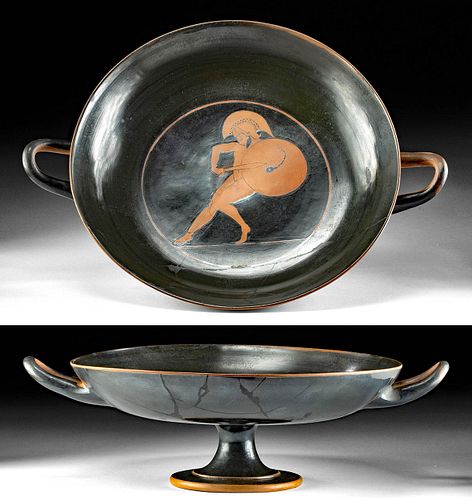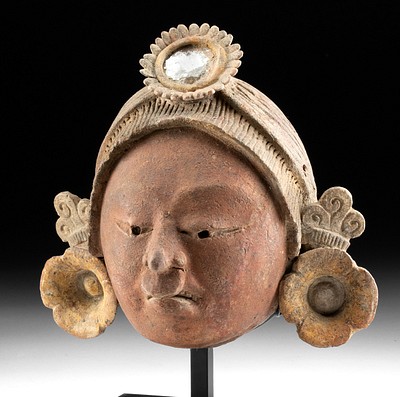Greek Attic Pottery Kylix, Hoplite w/ Scorpion Shield
Lot 11
About Seller
Artemis Fine Arts
686 S Taylor Ave, Ste 106
Louisville, CO 80027
United States
Selling antiquities, ancient and ethnographic art online since 1993, Artemis Gallery specializes in Classical Antiquities (Egyptian, Greek, Roman, Near Eastern), Asian, Pre-Columbian, African / Tribal / Oceanographic art. Our extensive inventory includes pottery, stone, metal, wood, glass and textil...Read more
Categories
Estimate:
$25,000 - $30,000
Absentee vs Live bid
Two ways to bid:
- Leave a max absentee bid and the platform will bid on your behalf up to your maximum bid during the live auction.
- Bid live during the auction and your bids will be submitted real-time to the auctioneer.
Bid Increments
| Price | Bid Increment |
|---|---|
| $0 | $25 |
| $300 | $50 |
| $1,000 | $100 |
| $2,000 | $250 |
| $5,000 | $500 |
| $10,000 | $1,000 |
| $20,000 | $2,500 |
| $50,000 | $5,000 |
| $100,000 | $10,000 |
| $200,000 | $20,000 |
About Auction
By Artemis Fine Arts
Jul 14, 2022
Set Reminder
2022-07-14 10:00:00
2022-07-14 10:00:00
America/New_York
Bidsquare
Bidsquare : Exceptional Antiquities Ethnographica Fine Art
https://www.bidsquare.com/auctions/artemis-gallery/exceptional-antiquities-ethnographica-fine-art-9692
Museum-worthy examples of classical antiquities (Egyptian, Greek, Roman, Near Eastern), Viking, Far East / Asian, Pre-Columbian, African / Tribal, Oceanic, Native American, Spanish Colonial, Fossils, Ancient Jewelry, Fine / Visual Arts, so much more! Artemis Fine Arts info@artemisgallery.com
Museum-worthy examples of classical antiquities (Egyptian, Greek, Roman, Near Eastern), Viking, Far East / Asian, Pre-Columbian, African / Tribal, Oceanic, Native American, Spanish Colonial, Fossils, Ancient Jewelry, Fine / Visual Arts, so much more! Artemis Fine Arts info@artemisgallery.com
- Lot Description
Ancient Greece, Athens, ca. 500 to 480 BCE. Simply breathtaking! A sensational pottery kylix of an imposing scale boasting a classical form with impressively thin walls that dramatically flare outwards to a broad, circular rim above a shallow basin, all sitting upon a conical leg and a tiered, discoid foot. Enveloped by a lavish coat of lustrous black glaze, the refined dish features a simple yet elegant aesthetic with a meticulously painted tondo at the center of its basin comprised of a red-figure warrior, perhaps a hoplite or citizen soldier. Depicted mostly nude, the ancient warrior wears only greaves and a high-crested Corinthian helmet with cheek guards pushed up, showcasing his athletic physique. He poses dynamically, leaning back as if to dodge a blow; his right leg straightened as he shifts his weight to his bent left leg, appearing to balance on the toes of his left foot. Size: 15.4" Diameter x 4.6" H (39.1 cm x 11.7 cm)
His rigid right arm folds at both the elbow and wrist in order to point his short sword or xiphos toward his hefty, circular shield, which not only echoes the form of the vessel, but is also painted with the image of a scorpion - a common practice in Ancient Greece that was intended to intimidate one's enemies during battle. The soldier gently bows his head, his handsome visage comprised of almond-shaped eyes, a straight, traditional Greek nose, and a petite mouth engulfed in a moustache and pointed beard. A slender red circle encompasses the hoplite, which is echoed by the bare terracotta of the annular rim, as well as additional red rings on the base and foot. A truly captivating dish, shimmering with gorgeous speckles of silvery iridescence reminiscent of the Ancient World!
The hoplites were heavily armed foot soldiers of ancient Greece. Athens mandated that all 18- to 20-year-olds participate in military service; however, during times of war, all male citizens through the age of 60 could be asked to serve. Hoplites carried a large, round, bronze-faced shield known as a hoplon in one hand, as seen in this example, and, in the other, an eight-foot-long wooden spear with a leaf-shaped iron head and a bronze butt spike. The butt spike was known as a sauroter, a "lizard killer," and, if the spear was broken, could be used as a weapon on the remaining end. It could also be used to stand the spear in soft ground or as a digging tool. This hoplite, however, is instead making use of his secondary weapon: his xiphos or short sword.
The image of a scorpion was not only intended to instill fear in one's enemies by calling to mind the pain of its sting and deadliness of its venom, but may have also served an apotropaic purpose as the arachnid was additionally regarded for its natural defensive mechanisms: its hard exoskeleton, pincers, and stinger. Adding another layer to the iconographical symbolism of this vessel, in Greco-Roman mythology, Diana (Artemis) used the Scorpion to sting Orion's foot, resulting in his death. Following this event, Jupiter (Zeus) made the scorpion a zodiac sign. Furthermore, as a symbol of the Zodiac Scorpio sign, scorpions were also associated with water - perhaps a reference to the contents of this lovely dish.
Virtually no ancient Greek paintings have survived the tests of time. This makes the painted compositions found on ceramic vessels like this example invaluable sources of information about ancient Greek visual art. Refined dishes like this kylix were not merely utilitarian pottery, but rather works of art in their own right, highly prized throughout the classical world.
Perhaps the most exciting innovation in Greek vessel painting was the red-figure technique, invented in Athens around 525 BCE and beloved by other artists of Magna Graecia. The red-figure technique allowed for much greater flexibility as opposed to the black-figure technique, for now the artist could use a soft, pliable brush rather than a rigid metal graver to delineate interior details, play with the thickness of the lines, as well as build up or dilute glazes to create chromatic effects. The painter would create figures by outlining them in the natural red of the vase, and then enrich these figural forms with black lines to suggest volume, at times perspectival depth, and movement, bringing those silhouettes and their environs to life.
According to the Walter's Museum, "Kylikes were the most common form of drinking vessel in ancient Greece... the tondo in the center was revealed after the contents of the cup were consumed (the scenes were sometimes amusing as well as artistic)... At the end of a symposium, the reveler might have used this kylix to participate in a game of kottabos, which involved flinging the dregs of his wine from his cup at a target."
Kylikes featuring a similar bearded soldier with a scorpion shield and crested helmet can be found at Harvard Art Museums under object number 1927.149 and Walters Art Museum under accession number 48.2747.
Provenance: private East Coast collection, New York, New York, USA, acquired before 2010
All items legal to buy/sell under U.S. Statute covering cultural patrimony Code 2600, CHAPTER 14, and are guaranteed to be as described or your money back.
A Certificate of Authenticity will accompany all winning bids.
PLEASE NOTE: Due to recent increases of shipments being seized by Australian & German customs (even for items with pre-UNESCO provenance), we will no longer ship most antiquities and ancient Chinese art to Australia & Germany. For categories of items that are acceptable to ship to Australia or Germany, please contact us directly or work with your local customs brokerage firm.
Display stands not described as included/custom in the item description are for photography purposes only and will not be included with the item upon shipping.
#170778Professionally repaired with break lines visible. A few minor areas of repair and restoration to rim. Some areas of repainting. Otherwise, excellent and remarkably preserved with impressive remaining pigments and detail.Condition
- Shipping Info
-
All shipping is handled in-house for your convenience. Your invoice from Artemis Gallery will include shipping calculation instructions. If in doubt, please inquire BEFORE bidding for estimated shipping costs for individual items.
-
- Buyer's Premium



 EUR
EUR CAD
CAD AUD
AUD GBP
GBP MXN
MXN HKD
HKD CNY
CNY MYR
MYR SEK
SEK SGD
SGD CHF
CHF THB
THB

















